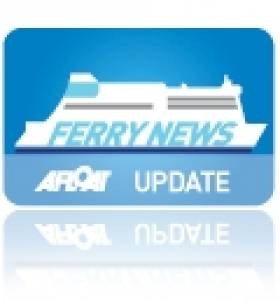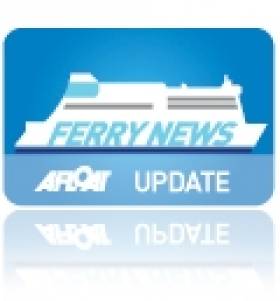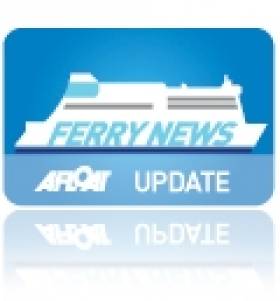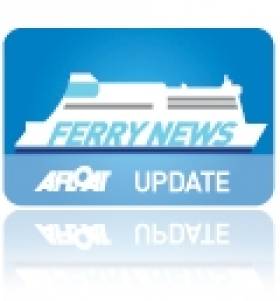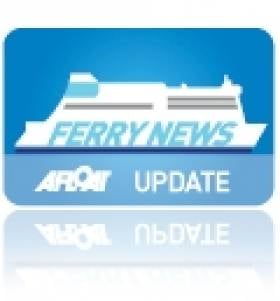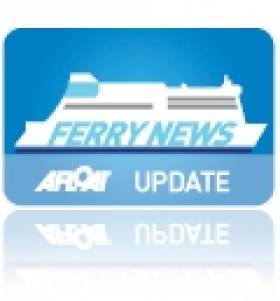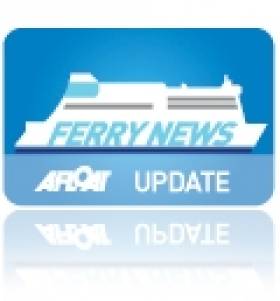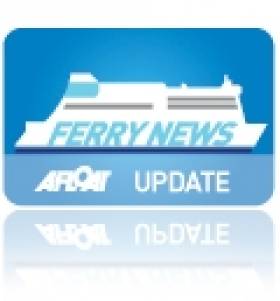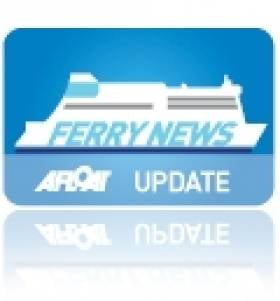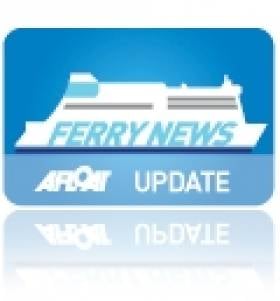Displaying items by tag: Oscar Wilde
Passengers Delayed in France after Ferry Technical Fault
#FerryFault- RTE News reports that passengers numbering around 1,000 had to spend the night on board an Irish Ferries vessel in the French port of Cherbourg after the crossing to Rosslare was cancelled.
Tonight's sailing from Rosslare to Cherbourg has also been cancelled. The 1987 built cruiseferry Oscar Wilde of 31,914 tonnes, was due to leave the French port at 8pm yesterday evening, but a fault with its radar system meant the journey could not go ahead.
An Irish Ferries spokesperson said that a ship may be able to get permission to sail in these circumstances provided there are good weather conditions, but the port of Cherbourg was enveloped in fog at the time.
All passengers on-board the ferry in Cherbourg, have now disembarked and alternative travel is being arranged for them.
An Irish Ferries spokesperson said that the nature of the technical problem necessitated the use of an expert technician and it would not be possible to have the ferry sail today.
For the latest information on sailings updates and contact details from ports, visit this link from Irish Ferries website.
Oscar Wilde to Start New Extra Dublin-Holyhead Sailings
#NewFERRY - As previously reported on Afloat.ie, Irish Ferries introduction of Epsilon as a third vessel on the Dublin-Holyhead route will be in mid-December and not tomorrow as previously indicated, writes Jehan Ashmore.
During this interim period the new extra sailings will intially be operated by the company's French routes ferry Oscar Wilde. She is scheduled to run the extra sailings with two round-trips daily, with the first crossing departing Dublin Port in the early hours of tomorrow morning.
When the Epsilon (2011/26,375gt) the chartered Italian-flagged 500 passenger ro-pax ferry comes on stream next month she will take over the sailing roster of Oscar Wilde in the run up to the festive period schedule.
Currently there are no Rosslare-Cherbourg sailings and according to the operator's website, the French service resumes on 8 December.
Ferry to France Forced to Abandon Approach to Port
#Ferry News – Due to heavy seas, Irish Ferries French route vessel, Oscar Wilde had to abandon its approach to Cherbourg last night.
The cruiseferry with more than 500 passengers had departed Rosslare and made several attempts to dock at the French port with the assistance of tugs in winds of up to 100km an hour.
One crew member suffered a broken leg during one of the failed attempts after a line snapped. He is still on board but a spokesperson for Irish Ferries says he is being well catered for on board. For more the Irish Examiner reports.
According to the Irish Ferries website, the vessel is currently offshore of Cherbourg and is awaiting an improvement in weather conditions before a further attempt to berth will be made at 13.00 hours local time today.
Oscar Reopens French Route Season
#FrenchRoute-Irish Ferries set sail for France today on board cruiseferry Oscar Wilde, which launches the 2013 season with a night-time departure on the Rosslare-Cherbourg route.
Irish Ferries are currently offering a fare from €99 car & driver & reserved seat. The price includes all taxes if booked at least 10 days in advance of travel date.
Oscar Wilde made her debut on the continental service in 2007, she has extensive passenger facilities and a wide choice of cabin accommodation, having served in Scandinavian waters with Color Line.
She recently returned to Rosslare, fresh from annual maintenance carried out at the Cammell Laird dry-dock facility in Birkenhead. In May the Rosslare-Roscoff route resumes a peak-season operated service.
Irish Ferries Fleet Start Dry-Docking Schedule
#FERRY NEWS- This morning Irish Ferries Dublin-Holyhead route cruiseferry Ulysses departed for Birkenhead, on the Mersey, for annual maintenance at the Cammell Laird dry-docks facility, writes Jehan Ashmore.
In place of Ulysses, the Isle of Inishmore has taken up her sailing roster, as previously reported on Afloat.ie, the ro-pax ferry had last night completed her own additional sailings to cope with increased demand over the festive season.
Isle of Inishmore which normally operates the Rosslare-Pembroke Dock route, will too be dry-docked for 15 days at the same facility, releasing Ulysses which is expected to return to service on 14 January, with the 08.50hrs sailing to Holyhead.
When the 'Inishmore' is off service, she will be joined by the central-corridor route's fast-craft Jonathan Swift, albeit in a separate dock, remaining there until 2 February.
Once work on Isle of Inishmore is completed, she is planned to vacate the dock on 30 January, which in turn will allow cruiseferry Oscar-Wilde to enter the next day, for her period of routine maintenance.
This will allow Isle of Inishmore to return to the Rosslare-Pembroke Dock route, where the Oscar Wilde is currently operating. The French routes ferry Oscar Wilde will finally return to launch the Cherbourg route on 27 February, followed by high-season sailings to Roscoff beginning in May.
Ferries in Collision at Rosslare Harbour
#FERRY NEWS - A Stena Line ferry was unable to dock in Rosslare last night after a collision with an Irish Ferries passenger craft in heavy winds.
TheJournal.ie reports that the Stena Europe ferry was attempting to dock at Rosslare Harbour after its arrival from Fishguard around 6pm when it made contact with the starboard bow of the Oscar Wilde, which was stationary in port.
RTÉ News says that neither vessel was badly damaged in the incident, but docking was postponed pending the departure of the Irish Ferries vessel, which was expected around 11.30pm last night.
More than 500 passengers and crew were on board the ferry at the time of the incident, which occurred amid gusts of up to 35 knots.
The return journey to Fishguard and this morning's Fishguard-Rosslare sailing were cancelled while an inspection of the vessel gets underway.
Wilde Nights Cabaret with Oscar
#FERRY CABARET – Holiday makers taking peak sailings with Irish Ferries routes to France can enjoy the Wilde Nights Cabaret Show, on board the cruiseferry Oscar Wilde (1987/31,914grt), writes Jehan Ashmore.
Irish Ferries will resume Mini Cruises on 27 August, starting on the Rosslare-Roscoff route and followed next month, they will be made available on Rosslare-Cherbourg sailings. Dependent on which route is taken, the time ashore can be up to 8 hours in France.
Currently there is a special fare for a car, driver and reserved seat from €99 single. The price includes all taxes, noting bookings should be made at least 10 days in advance of travel date. This fare is applicable to sailings made between 2nd September to 19th December.
For further details and other special fares click HERE.
# WINE FAIR MINI-CRUISE – Some passengers travelling on today's Irish Ferries inaugural sailing of the seasonal operated Rosslare-Roscoff route are taking a Wine Fair mini-cruise, writes Jehan Ashmore.
To celebrate the start of summer sailings to Roscoff, the special Wine Fair themed round-trip mini-cruise is been run in conjunction with a beverage supermarket located in the Breton port.
Before Oscar Wilde docks in France tomorrow morning those booked on the Wine-Fair sailing will hear lectures presented by wine-growers from leading wine regions. Among them are producers from Bordeaux, Loire Valley, Languedoc Roussillon, Loire Valley, South of France and the Rhône Valley.
Aside this weekend's Wine Fair mini-cruise, Irish Ferries have been running their regular mini-cruises which provide opportunities to purchase wine, beer on a DIY buying trip.
The first mini-cruise started this week on the Rosslare-Cherbourg and they are also available on sailings serving Roscoff. Mini-cruises are valid for travel from Ireland up to 19 June and from 27 August, subject to availability.
Irish Ferries 'Flagship' Returns to Dublin Route
#FERRIES - Ulysses arrived fresh from refit on the Dublin-Holyhead route yesterday after annual dry-docking at Cammell Laird, Birkenhead, writes Jehan Ashmore.
As previously reported on Alfoat.ie the Irish Ferries 'flagship' sailings on the central corridor route (also served by Jonathan Swift) where relieved by Isle of Inishmore earlier this month.
Isle of Inishmore departed Dublin Port last evening and headed to Liverpool Bay, where she anchored overnight. She docked at Cammell Laird this afternoon, where she too is to undergo annual overhaul.
With Isle of Inishmore off service on her usual Rosslare-Pembroke Dock route, the company's French routes vessel, Oscar Wilde is maintaining sailings.
On 19th February, the Oscar Wilde resumes service on Rosslare-Cherbourg route and she will also re-open the seasonal-only operated route to Roscoff which starts in May.
Bad Weather Continues to Disrupt Ferry Sailings
#FERRIES - As the adverse weather continues, ferry services across the Irish Sea remain affected, with several crossings cancelled, writes Jehan Ashmore.
Irish Ferries 08.05hrs sailing this morning from Dublin to Holyhead operated by Isle of Inishmore, departed over three hours later than her scheduled time.
Last night she had just been deployed on the route so to cover sailings usually operated by Ulysses, which went off-service for annual dry-docking at Cammell Laird, Birkenhead, as previously reported on Afloat.ie
In addition the fast-ferry craft sailing at 08.45hrs from Dublin Port served by the Jonathan Swift were cancelled and the following sailings are also cancelled:
Dublin -Holyhead 14.30hrs
Holyhead-Dublin 12.00hrs AND 17.15hrs
Passengers booked on the Jonathan Swift instead will be accommodated on the Isle of Inishmore. For further information on Dublin-Holyhead sailing updates click HERE.
On the Rosslare-Pembroke Dock service, sailings were too cancelled with last night's sailing from Wales, which are currently served by Oscar Wilde. She sailed as scheduled with this morning's 08.45hrs sailing to Pembroke Dock.
To keep updated on Rosslare-Pembroke Dock sailings click HERE.
For further information, Irish Ferries Central Reservations contact: 0818 300 400 and for Irish Ferries, Rosslare Harbour contact: 00353 53 9133158
STENA LINE
For information on sailing schedules and updates from the company's Ferrycheck facility click HERE.
To contact Stena Line call: 003531 204 77 99 when travelling to Britain or 0044 (0) 8705 755 755 when travelling to Ireland or Scotland
P&O FERRIES
Dublin to Liverpool sailing at 1500hrs is cancelled and passengers will be accommodated on either 2130hrs tonight or 0900hrs on Friday 6th January.
For other sailings and on the Larne-Cairnryan click HERE and to contact +44 (0) 871 66 44 777 if calling from UK
OR (01) 407 34 34 if calling from ROI. In addition to latest sailing infomation on +44 (0)845 832 8888
FOR OTHER FERRY OPERATORS
Please click this LINK and choose the relevant highlighted ferry route for further information.


























